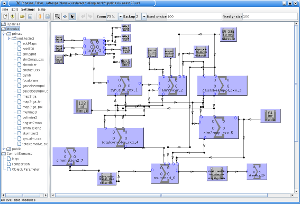|
|  |
380,000 years after the Big Bang, all the structure we see in the
universe today, stars, galaxies and galaxy clusters was present in
embryonic form as minute fluctuations in the density of matter. At
that time, the Universe became transparent. The light freed then is
still traveling through the cosmos today, and is measurable as the
cosmic microwave radiation. This radiation provides an accurate image
of the appearance of the Universe 13.8 billion years ago - precisely
at the epoch when it became transparent.
The microwave background shows us the embryonic density fluctuations
as miniscule variations in temperature, first predicted 40 years ago
by Rashid Sunyaev, now Director at the Max Planck Institute for
Astrophysics. The first discovery of these temperature fluctuations by
the COBE satellite, 25 years later, was awarded the Nobel Prize for
Physics in 2006.
The Planck space telescope will measure the microwave background for
between 18 and 30 months from a location close to the so-called second
Lagrange point of the Sun-Earth system. The satellite has one
high-frequency and one low-frequency instrument and a total of nine
different frequency bands. Temperature maps will not just provide an
image of the early phase of our Universe. They will also allow
scientists to answer important cosmological questions: What exactly
happened during the Big Bang? What is today's Universe made of? How
old is it? How did its structures form?
These measurements could also help verify the theory of
inflation. Space is supposed to have undergone a phase of explosive
expansion, when the universe was all of 10-35 seconds old. Minute
quantum fluctuations of the hypothetical energy field which drove this
spatial explosion are believed to have produced the density
fluctuations visible in the microwave background from which today's
galaxies emerged.
"The theory of inflation, with its claim to be able to trace the
fundamental characteristics of today's cosmos back to this bizarre
expansion epoch, is a seemingly unbelievable idea and it is absolutely
essential that it be tested experimentally," says Torsten
Enßlin, cosmologist and manager of the German Planck group
located at the Max Planck Institute in Garching.
It may never be possible to measure this epoch and so prove the theory
of inflation directly. However, the temperature fluctuations in the
microwave background conceal messages from this time that can be
decoded through statistical analysis of the measurements of
Planck. The Planck collaboration hopes to obtain first results by
studying the polarization of this radiation. They could thereby open a
new window to the very early Universe. "Current ideas about the first
split seconds in the life of the Universe could be verified, confirmed
or completely revised using such precise polarization measurements",
says the Garching-based scientist.
The Max Planck Institute for Astrophysics represents Germany in the
Planck Consortium and carried out part of the software development for
the project. It has developed a mission simulation software package
over the past decade for the data processing centers in Paris and
Trieste. Such simulations generate synthetic datastreams that resemble
the real one expected from the satellite. However, in the case of the
synthetic data streams, the exact properties of the virtual Universe
that produced them are known. This enables the testing and
optimization of the data processing procedures, critical elements of
this complex mission.
"Following the verification and calibration of the data transmitted
daily from the satellite to Earth, individual maps are generated for
the instruments' nine frequency bands. This happens in the two data
processing centers, in Trieste and Paris, depending on the wavelength
range," says Wolfgang Hovest, a software developer from the Garching
Planck group. These maps are then separated into different components,
such as galactic radio emission, dust radiation, microwaves from other
galaxies, and the cosmic microwave radiation.
The German Planck team also developed a database-supported graphic
workflow engine, the Planck Process Coordinator (known as the ProC).
This important component of the project software infrastructure
permits the construction, implementation, and monitoring of complex
data processing pipelines.
With the simulation package and the Process Coordinator, the Max
Planck Institute for Astrophysics has contributed key components to
the Planck mission. This project presents enormous challenges both to
astrophysicists and to computer scientists. As the leading German
partner, the Institute will be intensively involved in the scientific
evaluation of the data. In addition to the cosmological questions at
the heart of the project, research will also focus on more traditional
astrophysical objects, such as galaxy clusters or active galactic
nuclei.
Background Information:
The Planck mission is being carried out by the European-North American
Planck Consortium under the coordination of the ESA. Participating
countries include France, Italy, Germany, Great Britain, Denmark,
Finland, Switzerland, Spain, the USA and Canada. The project is
divided into two Consortia that develop and oversee the high frequency
and low frequency instruments, and are headed by Jean-Loup Puget from
the IAS in Paris and Nazzareno Mandolesi at the IASF/CNR in
Bologna. The ESA project scientist is Jan Tauber from ESTEC in the
Netherlands. The German participation at the Max Planck Institute for
Astrophysics (MPA) is funded by the German Aerospace Center (DLR) and
the Max Planck Society (MPS).
The Planck Surveyor will be launched together with the Herschel
satellite from the ESA spaceport in Kourou in French Guiana (South
America) using an Ariane 5 rocket. The planned launch date is April
16th. The transfer to the second Lagrange point of the Sun-Earth
system will take around three months. Two six-month-long
space-scanning operations are planned; a longer operating time with up
to four scanning operations may be possible, depending on coolant
consumption (Helium-3). All of the scientific data are due to be
published on the completion of the mission.
Links
 Planck-group at the Max Planck Institute for Astrophysics Planck-group at the Max Planck Institute for Astrophysics
 Planck Science Team at ESA Planck Science Team at ESA
For further information please contact:
Dr. Torsten Enßlin
Max Planck Institute for Astrophysics, Garching
Tel.: +49 89 30000-2243
email: tensslin mpa-garching.mpg.de mpa-garching.mpg.de
|





 mpa-garching.mpg.de
mpa-garching.mpg.de